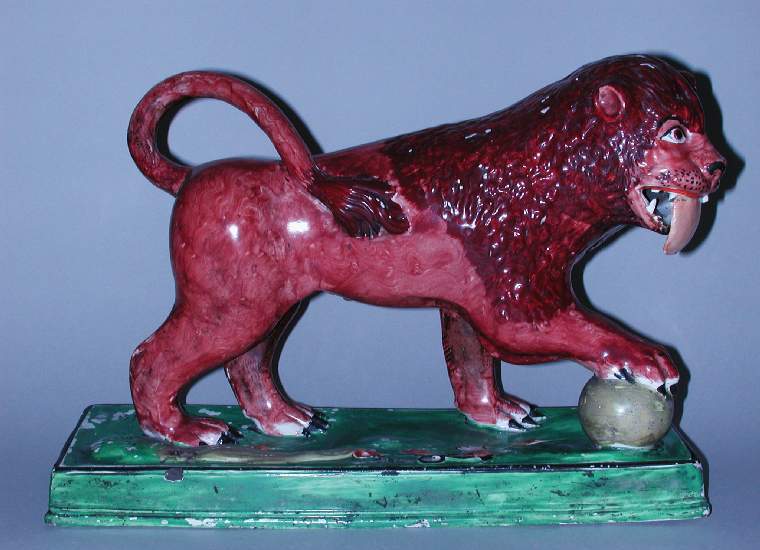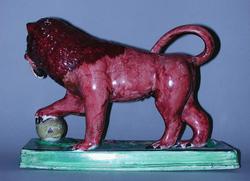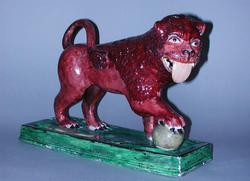Current Location: Gallery 27 (Glaisher)
Titles
Lion
Maker(s)
Production:
Benjamin Plant
(Probably)
Entities
Categories
Description
Earthenware figure, moulded with modelled additions, lead glazed and painted with polychrome enamels.
Large animal figure of a lion, with right foot raised on a ball and open mouth with protruding tongue, standing on a rectangular base. The tail tip and mane are modeled to suggest thick fur and coloured a rich red-brown. The rest of the body is painted more thinly in the same colour, with a stiff brush to indicate the texture of the pelt. The ball, or globe, is yellow-green. The figure is fully shaped in the round and decorated all over; there is a vent hole under the tail. The base is a bright grass green rectangular plinth, the top moulded, decorated with a swag and foliage at the front, and edged in black. The underside is recessed with several vent holes.
Notes
History note: Bought from Mr Acton at Brighton on 12 October 1905, for £4.10s (four pounds ten shillings), by Dr J.W.L. Glaisher, Trinity College, Cambridge.
Legal notes
Dr J. W. L. Glaisher bequest, 1928
Measurements and weight
Height: 27 cm
Acquisition and important dates
Method of acquisition: Bequeathed
(1928)
by
Glaisher, J. W. L., Dr
Dating
19th Century, Early
Circa
1818
-
1825
Note
Pearlware figures decorated with enamels were in production by 1780. They were generally made at smaller potteries and are rarely marked. A cheaper alternative to porcelain figures, they drew on a variety of sources, including sculpture and porcelain figures. Classical, biblical, mythological and literary subjects were popular, as were animals and representations of rural life, seasons and trades. These early figures are moulded, perhaps with moulded or modelled parts added, the bases often formed separately. After around 1810-1820, figures are often more vibrantly coloured and by c.1835 earlier methods had largely given way to three-part press-moulding, enabling cheaper production of figures for a growing market.
The figure is based on a pair of lions which stand at the entrance of the Loggia dei Lanzi in Florence, one a 2nd Century Roman figure and its companion sculpted by Flaminio Vacca in 1594. The lions were moved from the gardens of the Villa Medici in Rome to Florence in 1789. By the turn of the century, they were well known as small scale reproductions in stone, marble, plaster and bronze, which may have been used as a source for earthenware lions. These were probably intended as chimney ornaments or to be placed at opposite ends of a dresser or bookcase.
This is one of several similar Staffordshire lions in the Fitzwilliam collection. Dr Glaisher wrote in his notebook: ‘[it] is quite perfect, nothing made up. It was bought partly on this account, and partly because it is an interesting specimen with its red colour, and protruding tongue. Staffordshire lions are common though not often so large as this’.
People, subjects and objects depicted
Components of the work
Decoration
composed of
enamels
lead-glaze
Parts
Materials used in production
White earthenware
Techniques used in production
Moulded
: Earthenware, moulded and modelled, lead glazed and painted with enamels.
Inscription or legends present
- Text: No 2350 Large Staffordshire lion (with protruding tongue) b. in Brighton Oct 12, 1905.
- Location: Underside of base
- Method of creation: Rectangular paper label handwritten in black ink
- Type: Label
References and bibliographic entries
Identification numbers
Accession number: C.993-1928
Primary reference Number: 76507
Old object number: 2350
Stable URI
Audit data
Created: Saturday 6 August 2011
Updated: Monday 25 March 2024
Last processed: Tuesday 15 July 2025
Associated departments & institutions
Owner or interested party:
The Fitzwilliam Museum
Associated department:
Applied Arts






